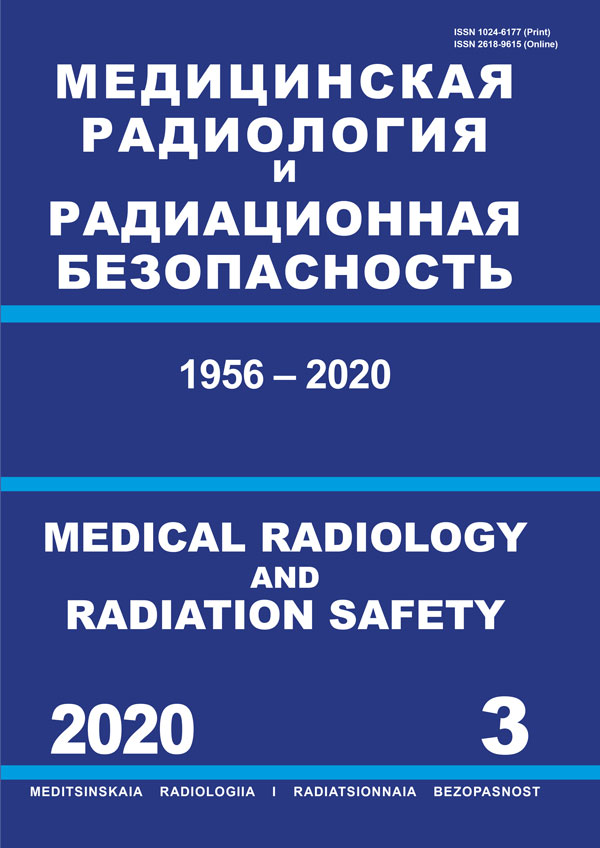Russian Federation
Purpose: Investigation of macro and micro distribution of 239PuO2 in the lungs of rats and metabolic parameters taking into account the variability of initial bronchoalveolar deposits. Materials and methods: Plutonium dioxide was single introduced intracheal into nonlinear male rats in the amount of 100 kBq / kg of body weight. The experimental animals were observed during their life. Lifetime measurement of radioactivity of the body and excreta and posthumous radiometry of organs were made. Auto and histoautoradiografic study of lungs and lymph nodes were performed. Results: 239PuO2 particles are removed from the respiratory organs most intensively during the first 7 days. Slowing of metabolic processes is observed in the period from 7 to 200 days. The data on post-mortem 239PuO2 content in the lungs and regional lymph nodes of rats indicate a decrease of the content of plutonium dioxide in the lungs and no reduction in the lymph nodes with time. Three periods of effective half-life of plutonium dioxide from the lungs were experimentally identified and calculated. These values indicate that the parameters of the respiratory clearance depend on the value of the initial radionuclide bronchoalveolar deposits. Conclusions: Сonsiderable variability of plutonium dioxide content in the lungs and regional lymph nodes of rats following intratracheal administration has been shown. Neven distribution of 239PuO2 with the expressed α-particle aggregation assumes a significant difference in the local fabric of absorbed radiation doses in the lungs, but does not exclude the possibility of their calculation on the respiratory system as a whole. Options clearance from the respiratory 239PuO2 correspond to the values of the initial bronchoalveolar deposits. The cleansing light of plutonium dioxide, in contrast to its soluble compounds, the role of radionuclide transport blood to other organs and tissues is not of great impotance . The results presented plutonium dioxide metabolism studies administered intratracheally, testifies to the fact that the implementation of the biological effects of the compounds can be expected mainly in the lungs. Evidence about the profile respiratory disease will be presented in a subsequent communication.
plutonium dioxide, lungs, metabolism
Промышленно важный и особо радиотоксичный радионуклид плутоний-239 – один из наиболее значимых элементов атомной индустрии и ядерного оружия. Он поступает в биосферу с выбросами АЭС, а также вследствие миграции из мест захоронения твердых отходов. В выбросах предприятий ядерного топливного цикла плутоний находится в виде оксидов, нитратов и комплексных соединений с органическими лигандами. Источником загрязнения плутонием могут быть некоторые этапы топливно-ядерного цикла, аварии на АЭС. Они образуются также при испытаниях ядерного оружия и уничтожении накопленных ядерных боеприпасов.
1. Buldakov L.A., Vasilenko I.Ja., Kalistratova V.S. i soavt. Radionukidy i proizvodstvennaja dejatel’nost’ cheloveka. - M. 1999. 160 s.
2. Vasilenko I.Ja., Vasilenko O.I. Plutonij // Jenergija: jekonomika, tehnika, jekologija. 2004. № 1. S. 60-63.
3. Plutonij. Radiacionnaja bezopasnost’. Pod redakciej akademika RAMN L.A. Il’ina. - M.: Izd.AT. 2005. 416 s.
4. Buldakov L.A., Ljubchanskij Je.R., Moskalev Ju.I., Nifatov A.P.. Problemy toksikologii plutonija. - M.: Atomizdat. 1969. 268 s.
5. Ljubchanskij Je.R., Kuz’menko O.V., Osovec S.V., Sokolova S.N. Prognoznye ocenki metabolizma i kancerogennogo dejstvija α-izluchatelej (234,235U, 237Np, 239Pu, 241Am) v ljogkih i skelete cheloveka: obobshhenie jeksperimental’nyh dannyh, poluchennyh na razlichnyh biologicheskih modeljah. - Ozjorsk. 2011. 304 s.
6. Moskalev Ju.I., Zalikin G.A., Nisimov P.G. i soavt. Problemy radiobiologii 238Pu. - M.: Jenergoatomizdat. 1990. 168 s.
7. Biologicheskie jeffekty ingalirovannyh radionuklidov. Publikacija 31 MKRZ /Per. s angl. Pod red. A.A.Moiseeva. - M.: Atomizdat. 1984. 136 s.
8. Beljaev I.K., Elatonceva N.B., Zarajskij A.V., Popov B.A. Kolichestvennye zakonomernosti modeli vnutritraheal’nogo vvedenija v jeksperimente //Radiobiologija. 1988. 28. № 3. S. 396-400.
9. Zalikin G.A., Nisimov P.G., Zhukova I.V. Metabolizm i toksichnost’ 238Pu pri intratraheal’nom vvedenii // Itogovaja konferencija o nauchno-tehnicheskom sotrudnichestve v oblasti radiacionnoj bezopasnosti mezhdu Ministerstvom Zdravoohranenija SSSR i Gosudarstvennym upravleniem po atomnoj bezopasnosti i zashhite ot izluchenija v period 1976- 1978 g.g., Vladimir, 28 avgusta - 1 sentjabrja 1978. 1979 g. S. 30- 37.
10. Zhorova E.S., Zalikin G., Nisimov P.G. Gistopatologija legkih krys pri porazhenii 238Pu. //Radiobiologija. 1989. 29. Vol. 2. S. 202-206.
11. Вrain J.D., Knutson D.E., Sorokin S.P. et al. Pulmonary distribution of particles given by intratracheal instillation or by aerosol inhalation // Environ. Res. 1976. Vol. 11. P. 13-33.
12. Bochvar I.A., Pashkova T.A. Rekomendacii po opredeleniju aktivnosti plutonija-239 v probah organov i tkanej jeksperimental’nyh zhivotnyh s pomoshh’ju avtomaticheskogo zhidkostnogo schetchika Del’ta-300, IBF MZ SSSR, inv. № R-362, M. 1984, 5 s.
13. Sanders C.L. Inhalation Toxicology of 238PuO2 and 239PuO2 in Sirian Golden Hanster // Radiat. Res. 1977. Vol. 70. P. 333-344.





